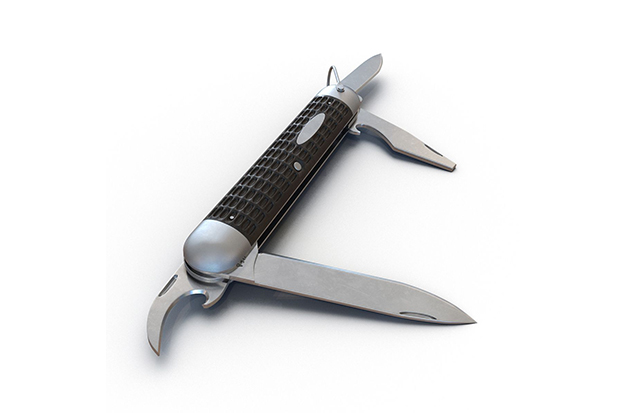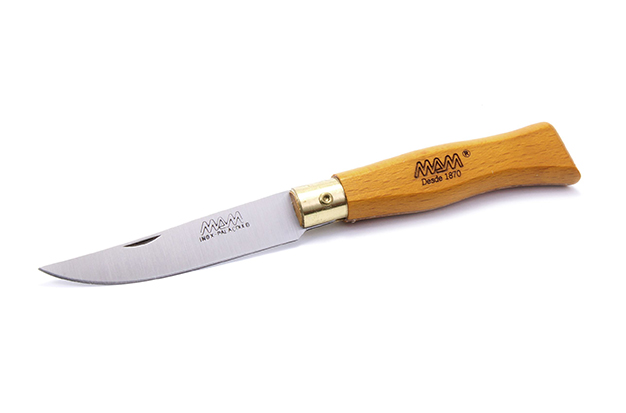
For making quick cuts, pocket knives are a practical tool. Knives come in a variety of designs and have a number of locking systems to keep the blades secure. No matter what kind of knife you’re using, it’s simple to close and put it back in your pocket, where it belongs.
Table of Contents
10 Types Of Pocket Knife Locks
Even if you are completely new to pocket knives, it shouldn’t take you very long to become quite proficient because the majority of knife locks are fairly simple to figure out if you know how they work and what to look for.
Typically, folding pocket knives have one of the following locking mechanisms:
- Slip Joint
- Ring Lock
- Frame Lock
- Liner Lock
- Button Lock
- Axis Lock
- Lockback
- Compression Lock
- Tri-Ad Lock
- Power Lock
The aforementioned knife locking mechanisms are fairly common, but there are a lot more uncommon blade locks that are only employed by specific companies or on a small number of knife models. Although almost all knife locks operate using the same principles as standard locks, you shouldn’t have too much trouble understanding any blade locks that aren’t covered here.
Check out my article on reasons why your pocket knife won’t close and how to fix them if your knife simply won’t close no matter how hard you try!
Almost any knife lock can typically be opened with ease if you can open a common pocket knife blade lock.
I’ll go over many of the most common knife locks below, detailing how to close and use each type. So let’s get right to it!
How Do You Fold A Pocket Knife? (10 Types)
Slip Joint
One of the more common and casual types of pocket knives are those with a slip joint lock. These non-locking folding blades are excellent for routine daily tasks even though they are not designed for heavy-duty work. This particular style of pocket knife is very simple to shut.
Simply press down on the back of the blade to close it. In essence, the knife will close with any downward pressure applied to the back of the blade.
Ring Lock
There are numerous, quite diverse variations of the ring lock. The most typical has just one locking piece. This can be found near the handle’s spine. It secures the locking piece while also being attached to the ring that is used for pulling and twisting.
This kind of lock resembles a gear with noticeable teeth. You can lock the blade at various angles depending on how many teeth it has. At the pivot of the blade will then be the infamous gear-like component.
All the models in this guide except for this one have locks that close slowly. You must insert your finger into the ring and pull it out carefully to complete this. Pushing on the blade’s blunt side is necessary at the same time. This motion accomplishes two things: it releases the blade and gets your hands out of the way. Finger-wrapping around the handle is something to avoid doing.
Frame Lock
A pocket knife with a frame lock has a lockable mechanism on the outside that keeps the knife open. The blade automatically locks when it is fully extended. Normally, the locking device is found behind the blade.
Use your thumb to move the locking portion of the frame out of the way of the blade to close this type of knife. You can simply press down on the back of the blade to move it down to the closed position after moving the locking part out of the way.
Liner Lock
The most popular locking mechanism currently being used is the liner lock design found in pocket knives. A spring-loaded wing on the liner lock knife can be used to lock it. The wing is a crucial component of one of the steel or titanium side plates (liners) that make up the handle’s skeleton.
The liner bends slantwise to the inside of the handle after the pocket knife has been opened. It catches the back of the head where it is beveled, impeding the movement there.
By bending the locking wing outward, the lock can be unlocked. Applying pressure with your thumb is the most practical method. When the pocket knife is closed, it is pressed up against a pawl that is drilled into the side of the blade’s back. This stops the blade from automatically opening.
Liner lock’s easy construction and simple operation are its main benefits. However, left-handed people may find the liner lock mechanism a little bit more challenging to use.
position.
Button Lock
Popular locking mechanisms include the button lock. The switchblade and rapid deployment knives are the ones that use it the most frequently. These features make it very desirable but also a rather risky kind of knife. Particularly if you don’t handle it carefully. You risk being surprised and hurt when the blade activates with just one press of the release button.
You must hold this knife with your thumb to securely close it. On the handle, facing up, should be the infamous release button. The blade must face outward. Following that, the process is the same as for a compression lock type. When the knife is closed to about one-fourth of its length, you release the button. Close it more times until the blade locks into the handle cavity.
Axis Lock
A real axis is used in the axis lock to actually close the pocket knife. It moves horizontally through the steel side plates of the handle frame’s notch notches. The locking axis overlaps the back of the blade from above as the knife is opened. The blade can’t turn back because of this. The omega spring, a tension wire with a u-shape, holds this axis in place.
The locking axis is retracted to unlock. The linings on the sides of the handle have cut-outs that allow access to its ends. In the locked position, the axle presses on the cam surface at the rear of the head, preventing it from opening by itself
The axis lock’s benefits include practical insensitivity to dynamic loads and resistance to contamination. With either the right or left hand, it is simple to use and lightweight. The comparatively brittle omega springs are its weak point.
Lockback
A metal spine that runs the length of the handle of this type of pocket knife secures the blade in place.
Find the finger cut along the knife’s spine to close the lockback. The locking mechanism can be released by applying pressure to this exposed portion of the spine. When you do this, the spine will be released, making it simple to close the knife.
Compression Lock
In a manner similar to a liner or frame type locking pocket knife, the compression lock is closed. It differs from others because it has a locking pin inside the handle and a notch at the base of the blade. A liner is utilized inside the handle of this type of lock. In order to keep the blade open or closed, the liner serves as a support. Basically, it’s the metal piece that you push to the side of the handle when handling.
You need only hold your knife in your dominant hand, and more specifically, your dominant thumb, to safely close it. With the handle cavity facing up and the blade facing outward, respectively. Your other hand should begin to gently close the blade. Remove your thumb once the blade has closed 1/4 of the way.
The liner automatically and precisely fits into the notch at the base of the blade whether the knife is closed or open. A locking pin and a slot for the liner are both present on the handle.
Tri-ad Lock
At the back of the knife is a space for the tri-ad lock. The blade is released from its compressed position when the blade is opened, acting as a release. The knife can now be closed with this alone.
Additionally, this lock has a cutout in the shape of a hammer. This can be found next to an extra locking pin at the rear of the blade tang. The key lies in that: it eliminates the vertical play of the blade.
The tang of the blade and the entire metal plate were a perfect fit. It has a slightly slanted locking mechanism. Instead of forcing the lock outward, it more often forces it in. As a result of the movement relieving the lock bar from impact, the knife is better protected from wear.
Power Lock
A different type of lockback is the power lock. It was initially designed to strengthen a 5″ blade’s locking force. When you look inside this lock, you’ll see that it has incredible power despite its plain exterior and seeming ordinariness.
A secondary cam is the key to both the locking feature’s strength and functionality. The tang interacts with a locking pin to release the blade. It’s very strong, this one. Its primary function is to halt rotation, and it is situated in the handle.
Halfway down the handle, the blade has a locking bar that cooperates with the counter-rotating cam that will later engage the tang.
A spring-loaded lever is also a part of this model. The location of this one is at the back of the knife handle. It drives the cam’s pivot to rotate. Thus, the sharp edge can be avoided by the finger at the base of the cam sliding against a concave surface on the top of the tang. Each of these components ensures that your pocket knife closes securely.

What Type Of Pocket Knife Locking Mechanism Is The Safest?
On this subject, discussions have never stopped. All of the locks discussed in this guide are extremely secure; they’re certainly more secure than non-locking pocket knives. The craftsmanship used to create these mechanisms is what will really matter. Compared to a locking system made to last, a cheap, shoddy locking system might be less secure.
Handling knives without a locking mechanism, such as the slip joint knife, requires extra caution.
What Should You Examine Before Using A Pocketknife?
Always keep an eye out for rust, damage, any broken parts, and any faulty locking mechanisms when closing or opening your pocket knife. These factors have the potential to harm the user, prevent the knife from working properly, or both.
What Safety Measures Are Advised When Using A Pocket Knife?
Using a pocket knife requires a lot of safety measures. Before using a pocket knife, make sure you are well-versed in knife safety procedures because even the smallest knives can be deadly.
Make sure none of your fingers are in contact with the knife’s blade before you close it. Any time you close a pocket knife, keep in mind that the blade will swing toward the handle.
A Pocketknife Should Be Cleaned After Each Use, Right?
Yes is the obvious response to that query. After every use, you should always clean your pocket knife. Knives can be hazardous to use if they get soiled or wet. Before you close the pocket knife, be sure to completely dry it after cleaning.
Conclusion
Most of the folding knives’ locking mechanisms are like this. If your knife from the online knife store employs one of these mechanisms, be sure to close it properly and safely while paying close attention to your closing technique. Any pocket knife you use can be closed and stored in the convenience of your pocket as long as it has a reliable locking mechanism.
Visit us at Grommet’s Knife & Carry to find out more, whether you’re a novice knife owner or an expert on a variety of knives.



